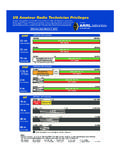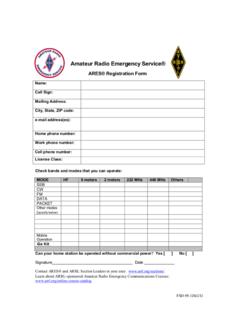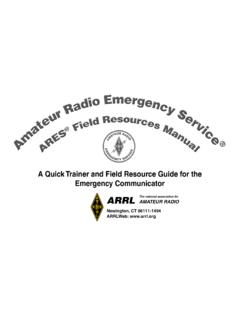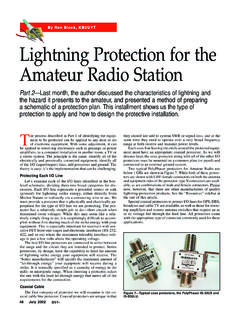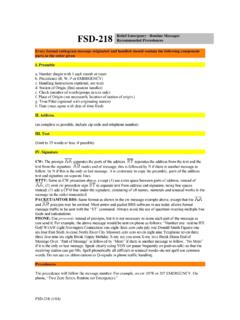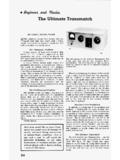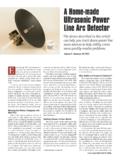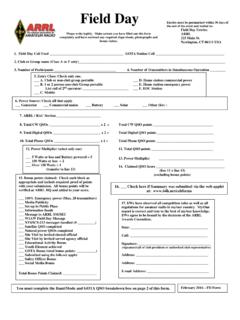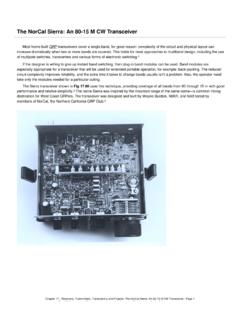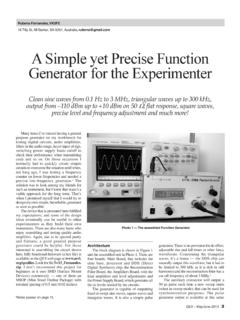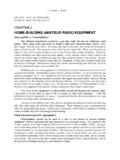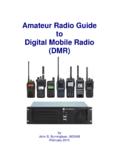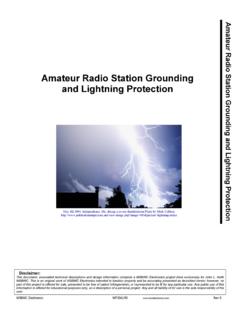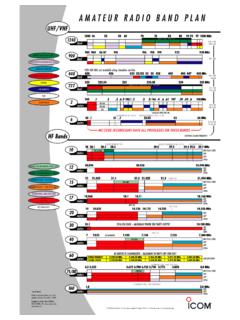Transcription of By Jim Maxwell, W6CF Amateur Radio
1 Jan 2000 QST - Copyright 2010 american Radio Relay league , Inc. - All Rights Reserved we approach the new millen- nium, it s a happy coincidence that Amateur Radio is now almost exactly 100 years old. It seems appropriate to stop for a moment and take a thoughtful trip to our beginning years, and even before. Why should we bother, you ask? Well, for many this will be a pleasant and nostalgic look back to the early days, the early days, of course, being any day earlier than today! Moreover, as will be seen as we progress through the events of this past century, there is much to be learned from our history. As Confucius once said, Study the past if you would divine the future. This article deals, for the most part, with Amateur Radio in the United States. This re-striction is not due to a lack of interest or a lack of importance of the broader topic of worldwide Amateur Radio , but purely for practical reasons.
2 Consider that Clinton B. DeSoto s classic 200 Meters and Down covers the history of Amateur Radio in the US only to 1936 but contains 184 1800s PrehistoryThe last few years of the 19th century set the stage for rapid development of commercial Radio and established the foundations of Amateur Radio . There were numerous early contribu-tors to the Radio art, such as the great Oersted, Ampere, Faraday, Henry, and others. However, discovery really shifted into high gear in 1873 with the controversial work of the Scotsman James Clerk maxwell (not related to the author of this article!). His work presented his theory of the electromagnetic field. maxwell was the originator of those sublime equations loved so dearly by students throughout the world. (Heaviside also made major contributions to maxwell s equations as they appear in modern textbooks, but that s another story.)Those who came before him, especially by jim maxwell , W6 CFAmateur Radio : In 1896 Marconi managed to communicate over a distance of 2 miles without wires.
3 In 1901 he spanned the , heavily influenced maxwell s work, but many of maxwell s contemporaries weren t convinced that his new theories were valid. It would take nothing less than rock-solid ex-perimental effort to break down those walls of doubt. The German physicist Heinrich Hertz did just that, performing a series of classic experiments in the late 1880s during which he generated, detected, and measured the proper-ties of electromagnetic waves predicted by maxwell s equations. Hertz, though, had no particular interest in those waves except for the intellectual challenges their discovery provided. Development of Radio for the use of mankind was left to others. The race was of the participants in the race to de-velop Radio was the young Italian Guglielmo Marconi. He had a strong interest in physics and electrical science as a boy. He studied the subject in school and became aware of the possibility of using electromagnetic waves for communicating.
4 In 1894 he started to work on the project in earnest. Two years later he was in England with what he felt was a useful Radio device. During a demonstration before British officials Marconi managed to communicate over a distance of 2 miles without wires. It was an astonishing feat at the time and it launched Marconi s professional career. The rest, as the old saw goes, is history. Who was the first Amateur Radio operator? We ll probably never know. Some would say it was Marconi. Marconi had a great fondness for Amateur Radio throughout his life, and consid-ered himself an Amateur at heart. Still, he chose to devote his life to competing in the commercial wireless marketplace; he never operated nor was licensed as an Amateur . Back to the original question, we ll prob-ably never know who the first Amateur Radio operator was, but the Englishman Leslie Miller is surely a leading contender for that Miller has a solid place in Amateur history as the first person to have published a description of a simple-to-build transmitter and receiver for an Amateur (and he used that word) audience.
5 His article appeared in the January 1898 issue of The Model Engineer and Amateur Electrician, published in London. Some of his readers clearly took the article to heart, for in the March 1898 issue E. A. wrote that he had a 2-inch spark coil and three solid brass balls, but needed more construction details. (The three brass balls were called for in one of the transmit-ter designs given in Miller s article.) No fewer than three more letters on the subject appeared in 1899 issues of the little magazine. The Yanks weren t far behind, with a construction article in the american Electrician in July 1899. An explosion of interest would occur over the next decade, but as the 19th century drew to a close, Amateur Radio was on its 00s The BeginningAs the 20th century began, commercial development gained speed. Marconi spanned the Atlantic with wireless in 1901, using high As10 0 Years of DiscoveryJan 2000 QST - Copyright 2010 american Radio Relay league , Inc.
6 - All Rights Reservedpower and giant antennas. Amateurs continued to tinker and experiment with their modest installations. A detailed construction article appeared in the Boston magazine Amateur Work in June 1902. It s clear that the experimenters at that time had already discovered the skill of scrounging that amateurs adhere to even today: one of the components recommended in that article was baling early transmitters all generated RF by means of discharging a capacitor across a gap, creating an oscillatory spark. These early spark transmitters did produce RF, but were broadband by their very nature, making it dif-ficult, and often impossible, for two neighbor-ing stations to be on the air at the same time. Receivers were simple detectors, generally coherers, later giving way to the more sensitive galena crystal was no regulation during those days, of course. Amateur call letters were self-assigned, and often consisted only of the operator s initials.
7 A hint of what the future held occurred in 1904 when the Englishman J. A. Fleming devel-oped the first vacuum diode: the Fleming Valve. In 1906 Lee DeForest added a grid to a Fleming Valve to make the first triode, naming it the Audion. Audions made very effective detec-tors, but were generally too expensive for most amateurs to use. It wasn t until some years later that it was realized that triodes could be made to generate RF. Meanwhile, crystal receivers and spark transmitters ruled the airwaves. This editorial in the November 1919 QST celebrated the return of Amateur Radio privileges after the end of World War 10s RegulationThe range of an Amateur station in the early 1900s was measured initially by yards, then by city blocks. As power increased and technology improved, ranges increased so that by 1912 a well-designed kilowatt spark station had a range of perhaps 100 miles. Those with more power could work several hundreds of miles.
8 Higher power generally meant more interference and the clamor for regulation had actually been investigating problems related to wireless since 1910. In 1912, after agonizing appraisal of more than a dozen different bills, Congress finally ap-proved the Radio Act of 1912. For the first time amateurs were to be licensed. The law also had a provision that at first was thought could bring the death of Amateur Radio : hams were restricted to the single wavelength of 200 meters. The general belief in those days was that long distance performance improved with longer wavelengths. The short wavelength of 200 meters was thought to be useless, and some expected that the amateurs, all crowded around this useless wavelength, would eventually give up and pursue other plot didn t work. Although there was an initial drop in numbers following the Radio Act of 1912, Amateur Radio in the US started growing again.
9 There were more than 6000 amateurs on the air by hams had extended their effective range by relaying messages through others, but it took a Hartford, Connecticut ham, Hiram Percy Maxim, 1WH (later 1AW) to recognize that messages could be sent more reliably over long distances if relay stations were organized. So, in 1914, the american Radio Relay league was born, and by late 1915 QST started publica-tion. The calls 1WH and 1AW look strange to some today, but they were the norm for the early years. Commerce Department rules issued in 1913 provided for Amateur call letters, but prefixes were not defined or required. Prefixes came later, in the mid to late that same time a miracle in receiver technology appeared on the scene. A New York Amateur by the name of Edwin H. Armstrong invented the tube-operated regenerative receiver in 1913, and in 1915 its design became public knowledge. This new receiver had greater sensitivity than the crystal detectors then in use.
10 Although vacuum tubes were expensive at the time, some amateurs started experimenting with Armstrong s year 1914 brought the madness of the Great War in Europe. By 1917 the US was fully involved and all ham operations in the US ended. The fact that amateurs formed a pool of trained Radio operators didn t go unnoticed Hiram Percy Maxim made certain of that! and some 4000 hams eventually wound up in the service of the nation. The word service is important here, for it emphasizes one of the fundamental functions of Amateur Radio to be of service to the public and to the war finally came to a close on Novem-ber 11, 1918. During the hostilities the Navy had been placed in control of all US Radio . As hams in uniform streamed home they ex-pected, quite reasonably, that the Navy would rescind the 1917 order that had closed them down. That was not to be the case. The Sec-retary of the Navy refused to permit amateurs back on the air.
